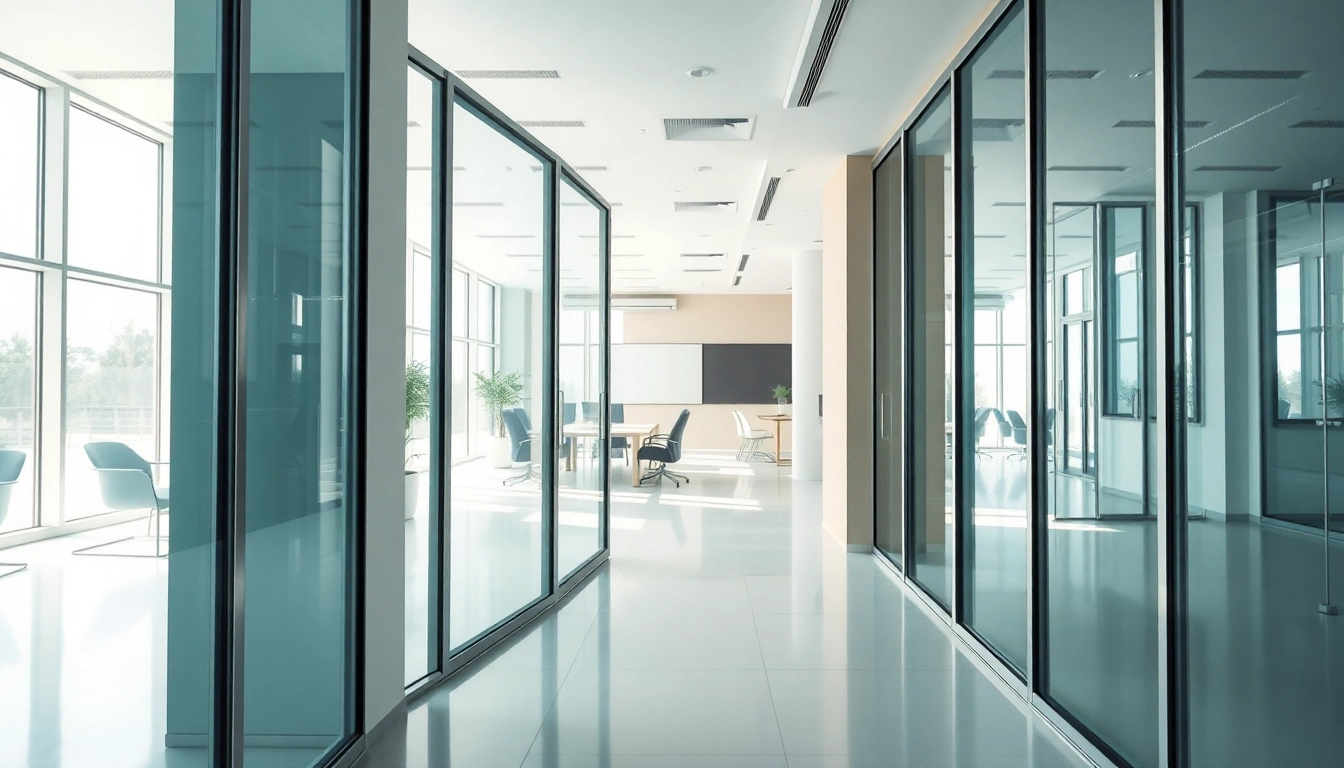Understanding Movable Glass Partitions
What Are Movable Glass Partitions?
Movable glass partitions are adaptable wall systems that allow for the flexible division of spaces while maintaining an open and airy environment. These structures typically consist of large glass panels that are mounted on tracks, enabling them to be moved aside or reconfigured as needed. Their design ensures that they blend seamlessly into various architectural styles, enhancing both functionality and aesthetics within different settings, be it an office, restaurant, or retail environment.
The main characteristic of movable glass partitions is their operability. Unlike traditional walls, which are fixed and permanent, movable glass partitions provide users the ability to quickly change a space’s layout, thus supporting dynamic usage and versatile design approaches.
Key Benefits of Using Movable Glass Partitions
Utilizing movable glass partitions offers numerous advantages that suit modern interior design approaches:
- Flexibility: These systems can be easily reconfigured to accommodate changing spatial needs, making them ideal for multipurpose areas.
- Natural Light: Because glass is a highly transparent material, it allows for an abundance of natural light to flow through, which can enhance occupant well-being.
- Aesthetic Appeal: Glass walls provide a modern and sleek look, often considered more attractive than conventional drywall.
- Sound Control: Many movable glass partitions come with sound-insulating properties, allowing for privacy in open environments.
- Space Optimization: By enabling the division and unification of spaces, these partitions can help maximize the utility of a square footage in commercial and residential spaces alike.
Common Applications and Use Cases
Movable glass partitions are gaining popularity across various sectors due to their versatility. Some common applications include:
- Office Spaces: They are widely used in corporate environments for creating meeting rooms or collaborative areas that can be adjusted depending on the number of people involved.
- Restaurants and Cafes: Glass partitions can define dining areas without compromising the openness of the overall space, allowing for intimacy or group gatherings.
- Educational Institutions: Classrooms can benefit from these partitions by easily reconfiguring layouts to facilitate different teaching methods or group activities.
- Healthcare Facilities: They are often used in clinics and hospitals for patient privacy while maintaining an open atmosphere that can reduce the feeling of confinement.
Design Considerations for Movable Glass Partitions
Choosing the Right Materials
Selecting the appropriate materials is crucial for ensuring the performance and longevity of movable glass partitions. The glass used can vary in type, thickness, and treatment:
- Tempered Glass: This type of glass is heat-treated to enhance its strength and durability, making it suitable for high-traffic areas.
- Laminated Glass: Consisting of two or more layers, this option offers increased safety and sound insulation.
- Low-E Glass: This energy-efficient option is designed to minimize the amount of infrared and ultraviolet light that can enter the space, which is particularly beneficial in large installations.
Color and Style Options
The visual appearance of movable glass partitions contributes significantly to the overall interior ambiance. Various frames and finishes are available, including:
- Frameless Designs: These offer a sleek, modern look where glass panels are joined with minimal hardware.
- Decorative Frames: For a more traditional aesthetic, aluminum or wooden frames can be incorporated, available in various finishes to align with the existing decor.
- Frosted Glass: This option provides additional privacy while still allowing light to permeate the space.
Integrating Technology and Functionality
Modern movable glass partitions are increasingly incorporating technology to further enhance usability. Options include:
- Smart Glass: This technology allows users to switch the glass from transparent to opaque, providing on-demand privacy.
- Integrated Lighting: LED lighting can be incorporated into the partitions for a stylish aesthetic while enhancing illumination in spaces.
- Automated Systems: Considerations for motorized tracks can add convenience for larger installations or those frequently reconfigured.
Installation and Maintenance of Movable Glass Partitions
Steps to Install Movable Glass Partitions
The installation process for movable glass partitions generally involves several key steps:
- Site Assessment: Evaluating the installation area to choose the right size and type of partition.
- Preparation of Tracks: Installing tracks into the ceiling or floor where the glass panels will be mounted.
- Panel Installation: Attaching glass panels to the tracks, ensuring stability and alignment.
- Finishing Touches: Adding any final fixtures or aesthetic elements to enhance the look.
Professional installation is recommended to ensure optimal safety and performance, as improper mounting could lead to structural issues or operational failures.
Maintenance Tips for Long-lasting Performance
Maintaining movable glass partitions is essential for their durability and functionality:
- Regular Cleaning: Use appropriate glass cleaners and soft cloths to avoid scratches and streaks.
- Check Hardware: Regularly inspect tracks and rollers for wear and tear; lubricate as needed.
- Monitor for Damage: Inspect for cracks or chips in the glass and address any issues immediately to prevent further damage.
Cost Considerations and Budgeting
The cost of movable glass partitions can vary widely based on materials, installation complexity, and customizations. Key factors include:
- Type of Glass: Special treatments, thickness, and design will influence pricing significantly.
- Size and Configuration: Larger spaces or unique layouts may require more complex systems, driving up costs.
- Installation Expenses: Engaging professionals for installation adds to the overall expense but ensures quality.
Budgeting for movable glass partitions should include not only upfront costs but also long-term maintenance and potential future adjustments.
Comparing Movable Glass Partitions to Traditional Options
Advantages Over Solid Walls
Movable glass partitions have numerous advantages compared to traditional solid walls:
- Adaptability: They can be reconfigured easily in response to changing spatial requirements.
- Light Distribution: Solid walls can block natural light, while glass partitions promote light movement throughout a space.
- Cost-effective Space Usage: The flexibility they offer can lead to cost savings in tenancy or leasing space as it adjusts to needs over time.
Sound Insulation and Privacy Features
While solid walls may typically provide superior sound insulation, many modern movable glass partitions now offer advanced sound-dampening technologies. Products are available that provide significant sound ratings (up to STC 50) to minimize noise pollution in busy environments.
Flexibility and Adaptability in Design
The unique design of movable glass partitions means they can significantly enhance space functionality:
- Multi-functional Areas: Spaces can evolve rapidly from quiet meeting areas to open collaboration spaces.
- Event Spaces: These partitions are perfect for venues that host various events and need adaptive space solutions.
Future Trends in Movable Glass Partition Design
Innovations in Partition Technology
As architectural trends evolve, so too do the technologies behind movable glass partitions. Innovations in the following areas are becoming increasingly common:
- Smart Technologies: Integration of IoT devices into partition systems can allow for intelligent space management and automation.
- Environmentally Friendly Materials: Manufacturers are focusing on sustainable materials, increasing the eco-friendliness of these partitions.
Sustainability and Eco-Friendly Solutions
The trend toward sustainability is shaping the design and manufacture of movable glass partitions. Focus areas include:
- Recycled Materials: Some manufacturers are utilizing recycled glass and frames to reduce environmental impact.
- Energy Efficiency: Advances in glass technology contribute to energy-efficient buildings by reducing heating and cooling loads.
Market Trends and Consumer Preferences
As consumers continue to prioritize aesthetics and functionality, the demand for movable glass partitions is expected to grow. Key market trends include:
- Design Versatility: Consumers are leaning toward customizable options that complement their specific needs and design schemes.
- Emphasis on Wellness: Increased awareness of how design impacts health drives demand for natural light and spacious designs within interior environments.



